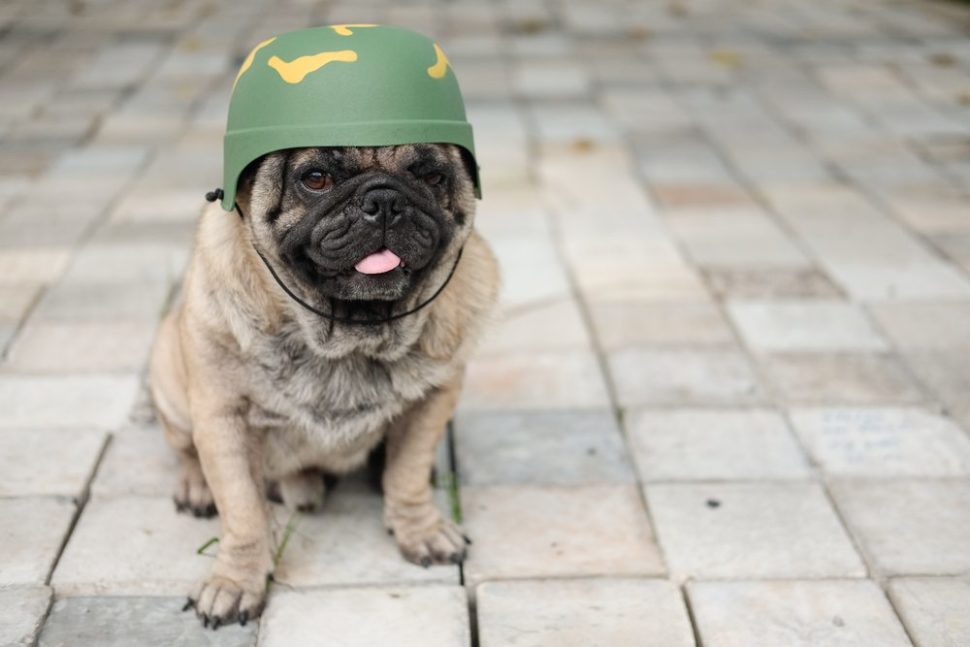“When nature has work to be done, she creates a genius to do it,” -Ralph Waldo Emerson
Biomimicry or biomimetics–from bio (life) and mimesis (imitation)–is the approach of learning from living beings and natural processes to solve scientific and technical problems.
Nature has long inspired humans, for good and for bad. While emulating DNA helps scientists build self-replicating, superfast computers, mimicking locusts gave the military the idea to create swarms of hive-minded drones.
Here we’ve gathered 8 bio-inspired creations, developed for military applications, based on natural products that took billions of years to naturally design.
1. Robo-Dogs
Boston Dynamics, an MIT spin-off startup that specializes in robotics, builds many robots that mimic animals.
The first robot that came out from BD labs was “BigDog”, a rough-terrain robot, which may look more like a mule, but was designed for military use: at 10 kmh, BigDog can carry heavy loads up to 150kg.
After testing it, the Marine Corps deemed BigDog’s size and loud noise as shortcomings that could give away Marines’ position.
But BD has since developed 9 more animal-inspired robots, like the four-legged WildCat, or SandFlea that can leap like a flea.
2. War Dolphins
Aside from taking inspiration from animals to build war robots, live animals themselves have long been used as military assets.
In the heyday of the Cold War, both the USA and the Soviet Union launched programs to train dolphins to carry out specific war duties, like mine detection.
In 2016, Russia’s Ministry of Defense bought five bottlenose dolphins. Although the Russians didn’t say what it intends to use the adorable mammals for, we’re pretty sure they aren’t for SeaWorld-esque entertainment.
For its part, The U.S. Navy National Marine Mammal Program has been exploring the use of dolphins and other marine animals for over 50 years.
3. Pigeon-Guided Missiles
Homing pigeons have long served as messengers, and during military conflicts, they were called “war pigeons”.
In the 1940s, Project Pigeon, later called Project Orcon, sought to use pigeons as natural guiding systems to bomb targets in Nazi Germany.
Inventor and psychologist B.F. Skinner trained pigeons to be put in cockpits inside the missile and then peck at a screen when they see the target.
Needless to say, the little birds wouldn’t survive the bombing. But, luckily for them, the project was canceled, soon to be outdated by more reliable and, well, realistic electronic guidance systems.
4. Chickens to Keep Nukes Warm
Chickens also were recruited to serve during wartime–this time by the British military.
Blue Peacock was a massive nuclear bomb designed to be detonated, as you’d guess, in Nazi Germany. But engineers realized that Blue Peacock’s equipment would be compromised by the freezing cold in winter.
They came up with an outlandish idea: encase chickens inside the nuke to keep it warm, with enough food, oxygen, and water for them to survive up to a week.
This plan, largely due to the end of the war and the introduction of more advanced tech, never materialized and eventually got scrapped.
5. Super Soldiers
DARPA scientists have long been working on technologies to provide maximum kill-proofing for soldiers.
Besides enemy bullets and bombs, DARPA sought to make American soldiers invulnerable to environmental threats such as infectious diseases. They also hoped to boost their endurance and overall physical performance.
This comprehensive protection approach was the goal of the project called Inner Armor, aimed at finding ways to endow soldiers with animal-like abilities.
For example, the report cites sea lions that could survive with little oxygen by slowing their heart rate and redirecting it to their core.
6. Homosexual Super Aphrodisiac
Here’s an idea that’d keep homophobes awake at night. Don’t worry, they weren’t the primary targets of this concept weapon.
In the mid-1990s, the U.S. Air Force entertained the idea of developing a chemical weapon that would make enemy soldiers sexually irresistible to each other.
The weapon would have carried a chemical substance that mimics a natural hormone produced by the human body, and once breathed by enemy soldiers they’d fall in each others’ arms.
It’s not clear how this chemical weapon would’ve helped the U.S. military win over its enemies: would they become warriors of lesser quality because of homosexual activity? Or, conversely, with the soldiers’ newfound adoration for each other, would they have turned into ultra-powerful “momma birds” looking to protect those closest to them?
7. Kamikaze Bat
During World War II, the US Air Force wanted to recruit bats and turn them into “kamikaze bombers”, following an idea proposed by Dr. Lytle S. Adams, a Pennsylvania dental surgeon, after the Pearl Harbor attack.
The idea was to train bats, load them with incendiary bombs, then drop them from planes over Japanese territories. Bats would use their echolocation to identify targets and set them on fire.
The project was validated but, after years of experiments, it was abandoned and bats never went to war. Perhaps if bats could have picked up on the training sooner they would have been used. However, the development of the atomic bomb was already underway.
8. Cats as CIA Agents
At the height of the Cold War, the CIA was driven on gaining as much intelligence and information as they could on Russian operations on American soil. At the time, the CIA was notorious for its strange and often bizarre experiments, such as the infamous MK Ultra operations, exploding cigars, and cats disguised as covert listening devices.
CIA agents had been trying for months to plant listening devices in a Russian compound in Washington D.C but found it impossible to either break in or plant a mole within the building.
While observing the compound, CIA agents realized that some of the Russian agents had a soft spot for the local feline inhabitants. To take advantage of this, they devised a plan to place listening devices within a cat in an attempt to gain intelligence on the inner workings of the compound.
With the help of a veterinarian, the CIA agents placed listening devices in the skull and ear canal of the cat and implanted a transmitting device within the cat itself.
Millions of dollars were spent on this experiment, and a date was eventually chosen to release the cat near the compound.
However, when the cat was finally released, it was almost immediately hit by a car and killed instantly. After this event, the project was quickly scrapped and all records of the operation were sealed until decades later. You can read a short report of the experiment written by CIA officials here.



















These things aren’t biomimicry, they’re just examples of times people used animals for military purposes or concepts. Biomimicry is specifically something like how airplane wings mimic the lift that birds’ wings produce, or how scientists copied the ridges on a geko’s finger pads to produce extra grippy gloves- those kinds of things.
Actually, the first one is probably biomimicry, but the others are just the use of animals.
War is hell. These animals-inspired inventions are the genius great contribution for the military to life-threatening terrain.
Technologies’ Breakthrough!